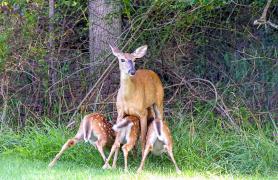Share the love with wildlife moms this Mother’s Day
Everything from bugs to birds to bears has a mom that laid an egg or gave birth. Wildlife moms like bears work hard to raise their young, and others like turtles just look for the best nesting place they can find. Either way, wildlife moms spend lots of energy bringing young critters into the world. Spotting wild families in our woods, prairies, and streams is one of the best things about spring. Thanks, mom!
Rainbow Trout
Before she lays her eggs, a mother rainbow trout will fan a shallow nest in the riffles with her tail. After the male fertilizes the eggs, she will swim upstream and fan up a little more gravel. This will wash down and settle over the eggs, protecting them until they hatch.
How you can help
Do your part to keep trash and pollution out of streams, especially in the Ozark region. Wild trout need clean, cold water to thrive.
Virginia Opossum
Possum moms have childcare in the bag. Literally. Newborn possum babies creep into their mom’s tummy pouch, where they nurse until they are fully formed. Even after they leave the pouch, babies will ride on mom’s back until they are about 4 ½ months old.
How you can help
Possums are wild animals, so help them stay that way. Don’t leave out pet food or smelly trash that will attract them close to your house.
Killdeer
Killdeer parents often scrape out a shallow basin in bare soil or gravel, and mom will lay her eggs among the dirt or rocks. If a predator comes too close, both mom and dad will fake a broken wing to lure it away. Once the eggs hatch, the babies leave their dusty cradle in a day or two, ready to scratch for themselves.
How you can help
Steer clear of bird nests wherever you find them. Leaving nests alone helps keep predators from detecting them and gives parents the peace they need to keep eggs warm until they hatch.
American Black Bear
Mama bears keep a sharp eye on their cubs, especially when the family is out foraging for food. If a cub cries, mom comes running. And if a strange bear (or human) comes too close, the mama bear will charge the challenger.
How you can help
Are you in the Ozarks? Then you’re in Missouri’s bear country. Be bear aware, and give bears plenty of room if you see them in the wild. To keep bears from sniffing around your place, don’t leave out pet food, livestock food, or smelly garbage and greasy grills.
Monarch
To help their young get off to a good start, monarch moms lay their eggs on milkweed plants. These are the only kinds of plants their caterpillars can eat. After they hatch, caterpillars gobble about 200 times their hatch weight in milkweed leaves before they become chrysalises.
How you can help
If you have a sunny spot in your yard, plant some milkweeds there. Be sure to get plants grown without insecticides. Monarchs will visit your milkweeds, and you may soon find striped caterpillars chomping the leaves.
Crayfish
Mama crayfish carry their eggs under their tails using little legs called swimmerets. Mom waves her swimmerets back and forth to keep water moving around the eggs. When the eggs hatch, the baby crayfish will hang on to mom’s tail for a little while before dropping off.
How you can help
Clean up a stream and don’t dump stuff into storm drains. Crayfish, fish, and other stream critters need clean water to live in.
Five-Lined Skink
These lizard moms brood their eggs, just like birds do. They wrap their bodies around or over their eggs, and they remove rotten eggs from the nest. Skink moms stay with their eggs until they hatch.
How you can help
Five-lined skinks occur statewide. If you have a rocky, south-facing slope, you probably have skinks. Keep your pets away from them, and they’ll do just fine.














Also In This Issue

This Issue's Staff
Les Fortenberry
Karen Hudson
Angie Daly Morfeld
Noppadol Paothong
Marci Porter
Mark Raithel
Laura Scheuler
Matt Seek
David Stonner
Nichole LeClair Terrill
Stephanie Thurber
Cliff White






















